Cheng-Zhi Anna Huang
Adaptive Accompaniment with ReaLchords
Jun 17, 2025Abstract:Jamming requires coordination, anticipation, and collaborative creativity between musicians. Current generative models of music produce expressive output but are not able to generate in an \emph{online} manner, meaning simultaneously with other musicians (human or otherwise). We propose ReaLchords, an online generative model for improvising chord accompaniment to user melody. We start with an online model pretrained by maximum likelihood, and use reinforcement learning to finetune the model for online use. The finetuning objective leverages both a novel reward model that provides feedback on both harmonic and temporal coherency between melody and chord, and a divergence term that implements a novel type of distillation from a teacher model that can see the future melody. Through quantitative experiments and listening tests, we demonstrate that the resulting model adapts well to unfamiliar input and produce fitting accompaniment. ReaLchords opens the door to live jamming, as well as simultaneous co-creation in other modalities.
FLAM: Frame-Wise Language-Audio Modeling
May 08, 2025Abstract:Recent multi-modal audio-language models (ALMs) excel at text-audio retrieval but struggle with frame-wise audio understanding. Prior works use temporal-aware labels or unsupervised training to improve frame-wise capabilities, but they still lack fine-grained labeling capability to pinpoint when an event occurs. While traditional sound event detection models can precisely localize events, they are limited to pre-defined categories, making them ineffective for real-world scenarios with out-of-distribution events. In this work, we introduce FLAM, an open-vocabulary contrastive audio-language model capable of localizing specific sound events. FLAM employs a memory-efficient and calibrated frame-wise objective with logit adjustment to address spurious correlations, such as event dependencies and label imbalances during training. To enable frame-wise supervision, we leverage a large-scale dataset with diverse audio events, LLM-generated captions and simulation. Experimental results and case studies demonstrate that FLAM significantly improves the open-vocabulary localization capability while maintaining strong performance in global retrieval and downstream tasks.
ReaLJam: Real-Time Human-AI Music Jamming with Reinforcement Learning-Tuned Transformers
Feb 28, 2025Abstract:Recent advances in generative artificial intelligence (AI) have created models capable of high-quality musical content generation. However, little consideration is given to how to use these models for real-time or cooperative jamming musical applications because of crucial required features: low latency, the ability to communicate planned actions, and the ability to adapt to user input in real-time. To support these needs, we introduce ReaLJam, an interface and protocol for live musical jamming sessions between a human and a Transformer-based AI agent trained with reinforcement learning. We enable real-time interactions using the concept of anticipation, where the agent continually predicts how the performance will unfold and visually conveys its plan to the user. We conduct a user study where experienced musicians jam in real-time with the agent through ReaLJam. Our results demonstrate that ReaLJam enables enjoyable and musically interesting sessions, and we uncover important takeaways for future work.
Exploratory Study Of Human-AI Interaction For Hindustani Music
Nov 21, 2024Abstract:This paper presents a study of participants interacting with and using GaMaDHaNi, a novel hierarchical generative model for Hindustani vocal contours. To explore possible use cases in human-AI interaction, we conducted a user study with three participants, each engaging with the model through three predefined interaction modes. Although this study was conducted "in the wild"- with the model unadapted for the shift from the training data to real-world interaction - we use it as a pilot to better understand the expectations, reactions, and preferences of practicing musicians when engaging with such a model. We note their challenges as (1) the lack of restrictions in model output, and (2) the incoherence of model output. We situate these challenges in the context of Hindustani music and aim to suggest future directions for the model design to address these gaps.
Hierarchical Generative Modeling of Melodic Vocal Contours in Hindustani Classical Music
Aug 26, 2024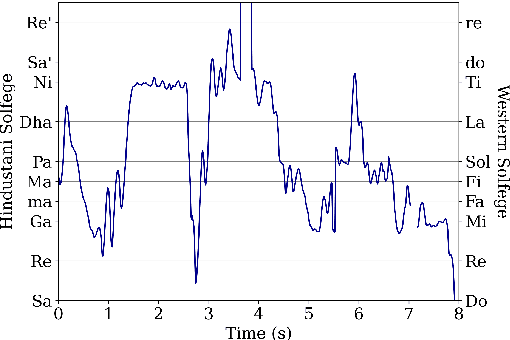
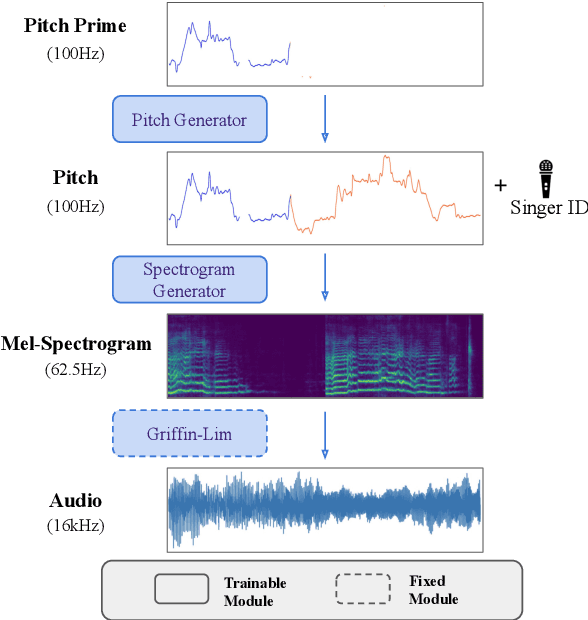
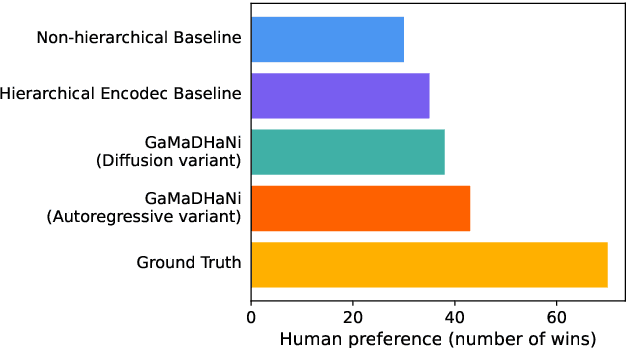
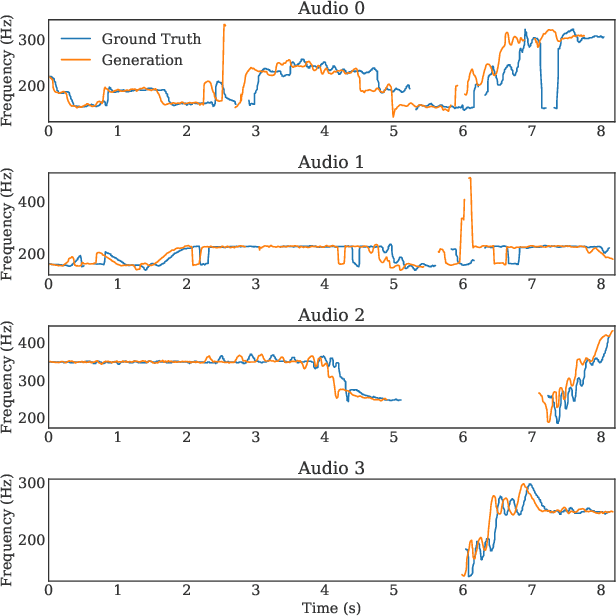
Abstract:Hindustani music is a performance-driven oral tradition that exhibits the rendition of rich melodic patterns. In this paper, we focus on generative modeling of singers' vocal melodies extracted from audio recordings, as the voice is musically prominent within the tradition. Prior generative work in Hindustani music models melodies as coarse discrete symbols which fails to capture the rich expressive melodic intricacies of singing. Thus, we propose to use a finely quantized pitch contour, as an intermediate representation for hierarchical audio modeling. We propose GaMaDHaNi, a modular two-level hierarchy, consisting of a generative model on pitch contours, and a pitch contour to audio synthesis model. We compare our approach to non-hierarchical audio models and hierarchical models that use a self-supervised intermediate representation, through a listening test and qualitative analysis. We also evaluate audio model's ability to faithfully represent the pitch contour input using Pearson correlation coefficient. By using pitch contours as an intermediate representation, we show that our model may be better equipped to listen and respond to musicians in a human-AI collaborative setting by highlighting two potential interaction use cases (1) primed generation, and (2) coarse pitch conditioning.
Improving Source Separation by Explicitly Modeling Dependencies Between Sources
Mar 28, 2022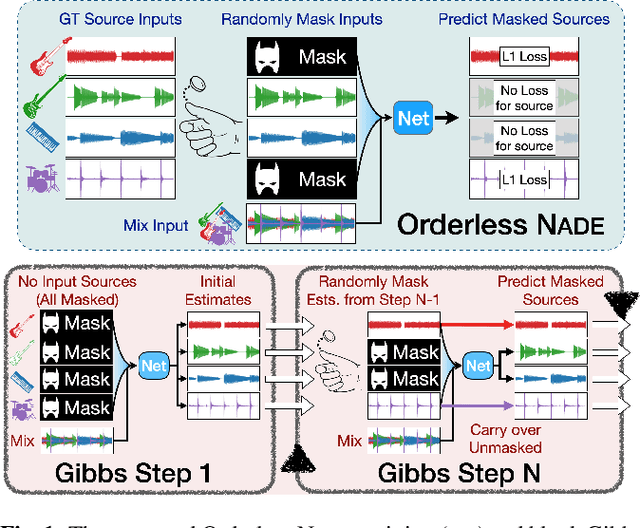
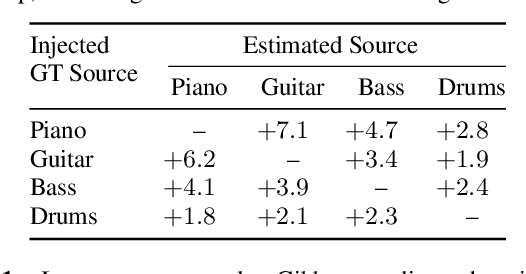
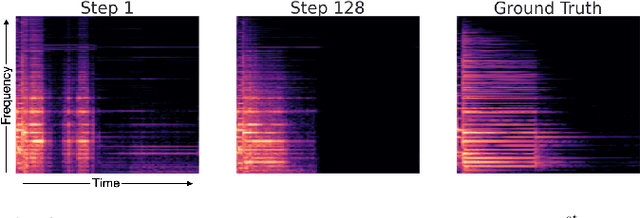
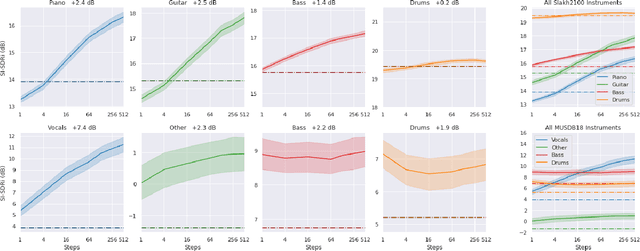
Abstract:We propose a new method for training a supervised source separation system that aims to learn the interdependent relationships between all combinations of sources in a mixture. Rather than independently estimating each source from a mix, we reframe the source separation problem as an Orderless Neural Autoregressive Density Estimator (NADE), and estimate each source from both the mix and a random subset of the other sources. We adapt a standard source separation architecture, Demucs, with additional inputs for each individual source, in addition to the input mixture. We randomly mask these input sources during training so that the network learns the conditional dependencies between the sources. By pairing this training method with a block Gibbs sampling procedure at inference time, we demonstrate that the network can iteratively improve its separation performance by conditioning a source estimate on its earlier source estimates. Experiments on two source separation datasets show that training a Demucs model with an Orderless NADE approach and using Gibbs sampling (up to 512 steps) at inference time strongly outperforms a Demucs baseline that uses a standard regression loss and direct (one step) estimation of sources.
MIDI-DDSP: Detailed Control of Musical Performance via Hierarchical Modeling
Dec 17, 2021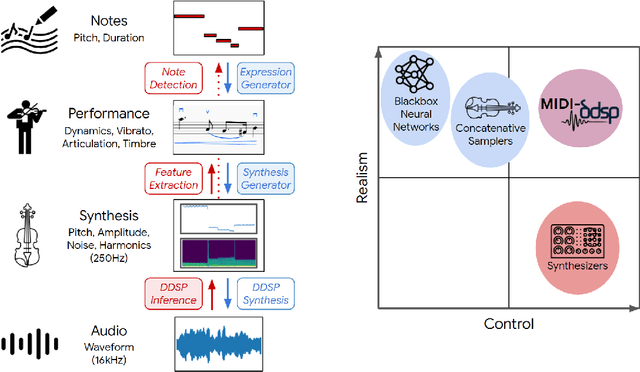
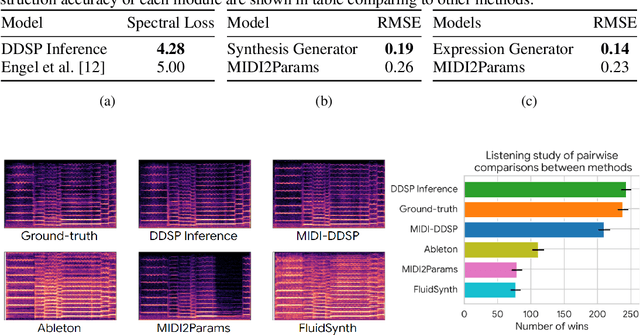
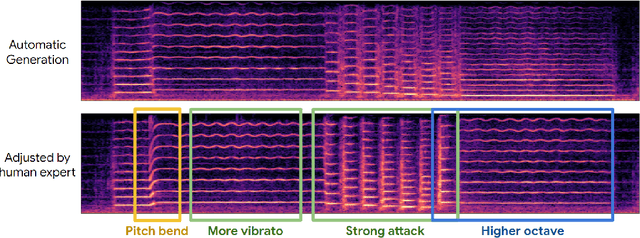

Abstract:Musical expression requires control of both what notes are played, and how they are performed. Conventional audio synthesizers provide detailed expressive controls, but at the cost of realism. Black-box neural audio synthesis and concatenative samplers can produce realistic audio, but have few mechanisms for control. In this work, we introduce MIDI-DDSP a hierarchical model of musical instruments that enables both realistic neural audio synthesis and detailed user control. Starting from interpretable Differentiable Digital Signal Processing (DDSP) synthesis parameters, we infer musical notes and high-level properties of their expressive performance (such as timbre, vibrato, dynamics, and articulation). This creates a 3-level hierarchy (notes, performance, synthesis) that affords individuals the option to intervene at each level, or utilize trained priors (performance given notes, synthesis given performance) for creative assistance. Through quantitative experiments and listening tests, we demonstrate that this hierarchy can reconstruct high-fidelity audio, accurately predict performance attributes for a note sequence, independently manipulate the attributes of a given performance, and as a complete system, generate realistic audio from a novel note sequence. By utilizing an interpretable hierarchy, with multiple levels of granularity, MIDI-DDSP opens the door to assistive tools to empower individuals across a diverse range of musical experience.
AI Song Contest: Human-AI Co-Creation in Songwriting
Oct 12, 2020


Abstract:Machine learning is challenging the way we make music. Although research in deep generative models has dramatically improved the capability and fluency of music models, recent work has shown that it can be challenging for humans to partner with this new class of algorithms. In this paper, we present findings on what 13 musician/developer teams, a total of 61 users, needed when co-creating a song with AI, the challenges they faced, and how they leveraged and repurposed existing characteristics of AI to overcome some of these challenges. Many teams adopted modular approaches, such as independently running multiple smaller models that align with the musical building blocks of a song, before re-combining their results. As ML models are not easily steerable, teams also generated massive numbers of samples and curated them post-hoc, or used a range of strategies to direct the generation, or algorithmically ranked the samples. Ultimately, teams not only had to manage the "flare and focus" aspects of the creative process, but also juggle them with a parallel process of exploring and curating multiple ML models and outputs. These findings reflect a need to design machine learning-powered music interfaces that are more decomposable, steerable, interpretable, and adaptive, which in return will enable artists to more effectively explore how AI can extend their personal expression.
* 6 pages + 3 pages of references
The Bach Doodle: Approachable music composition with machine learning at scale
Jul 14, 2019



Abstract:To make music composition more approachable, we designed the first AI-powered Google Doodle, the Bach Doodle, where users can create their own melody and have it harmonized by a machine learning model Coconet (Huang et al., 2017) in the style of Bach. For users to input melodies, we designed a simplified sheet-music based interface. To support an interactive experience at scale, we re-implemented Coconet in TensorFlow.js (Smilkov et al., 2019) to run in the browser and reduced its runtime from 40s to 2s by adopting dilated depth-wise separable convolutions and fusing operations. We also reduced the model download size to approximately 400KB through post-training weight quantization. We calibrated a speed test based on partial model evaluation time to determine if the harmonization request should be performed locally or sent to remote TPU servers. In three days, people spent 350 years worth of time playing with the Bach Doodle, and Coconet received more than 55 million queries. Users could choose to rate their compositions and contribute them to a public dataset, which we are releasing with this paper. We hope that the community finds this dataset useful for applications ranging from ethnomusicological studies, to music education, to improving machine learning models.
Counterpoint by Convolution
Mar 18, 2019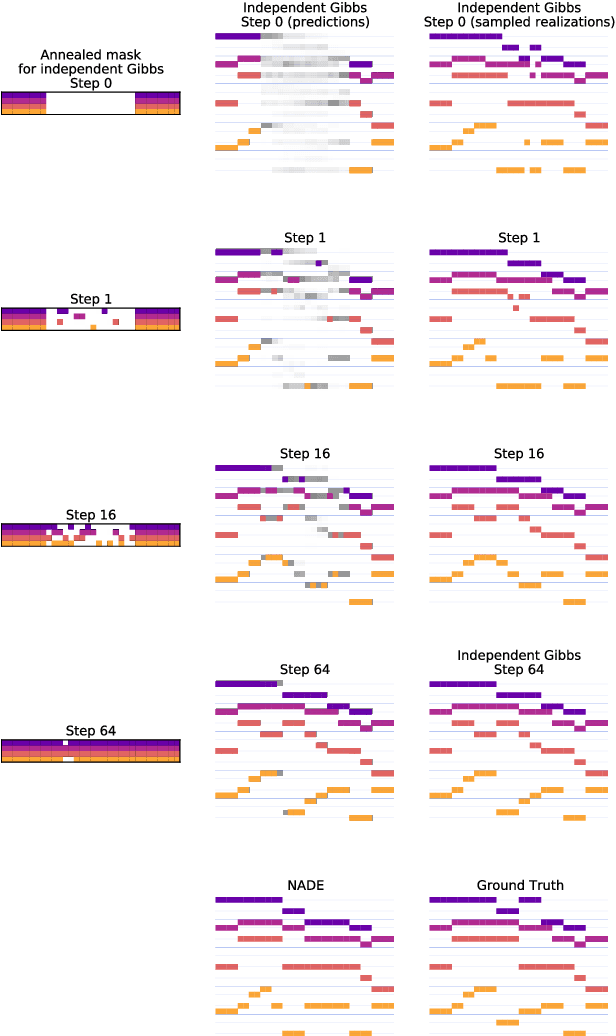

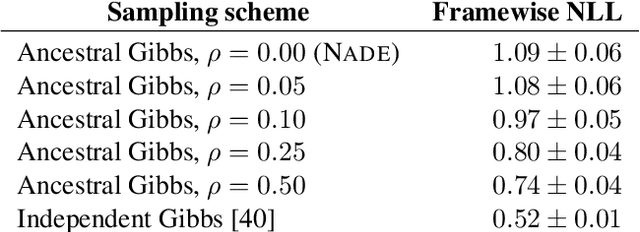
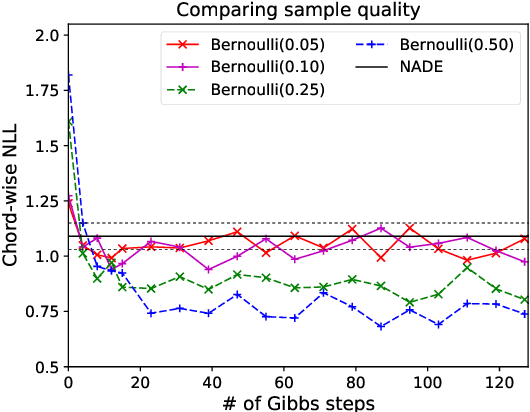
Abstract:Machine learning models of music typically break up the task of composition into a chronological process, composing a piece of music in a single pass from beginning to end. On the contrary, human composers write music in a nonlinear fashion, scribbling motifs here and there, often revisiting choices previously made. In order to better approximate this process, we train a convolutional neural network to complete partial musical scores, and explore the use of blocked Gibbs sampling as an analogue to rewriting. Neither the model nor the generative procedure are tied to a particular causal direction of composition. Our model is an instance of orderless NADE (Uria et al., 2014), which allows more direct ancestral sampling. However, we find that Gibbs sampling greatly improves sample quality, which we demonstrate to be due to some conditional distributions being poorly modeled. Moreover, we show that even the cheap approximate blocked Gibbs procedure from Yao et al. (2014) yields better samples than ancestral sampling, based on both log-likelihood and human evaluation.
 Add to Chrome
Add to Chrome Add to Firefox
Add to Firefox Add to Edge
Add to Edge